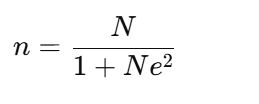Determining the right sample size is an important step in dissertation research. It helps ensure that your results are accurate, reliable, and truly represent the larger population. If your sample is too small, your findings may be misleading. If it’s too large, you may waste time and resources. That’s why knowing how to calculate the correct sample size is essential. Two popular methods used in academic research are Slovin’s formula and Cochran’s formula. Each method has its own strengths and is suited for different situations. In this blog, we’ll explain what sample size means, why it matters, and how to use both Slovin’s and Cochran’s formulas to calculate it step-by-step.
What is Sample Size in Research?
Sample size refers to the number of people or items selected from a larger group, known as the population, to take part in a study. In research, especially quantitative studies, we often cannot study the whole population. So, we select a sample that represents the entire group. This helps researchers collect data, analyze trends, and draw conclusions without needing to study every individual.
Having the right sample size is very important. If your sample is too small, the results may not reflect the true behavior of the population. A properly calculated sample size increases the chances of getting accurate, meaningful results. It also helps ensure that your findings can be generalized to the whole population and that they are statistically significant.
Why is Sample Size Important for a Dissertation?
Choosing the right sample size is key to getting accurate and reliable results in your dissertation. A good sample size increases confidence in your findings. It helps reduce errors and shows that your results truly reflect the views or behavior of the whole population. This is important when trying to prove or disprove your research questions.
If your sample is too small, your data may not be valid or trustworthy. If it’s too large, it can waste time, effort, and resources. Many universities and academic guidelines recommend using a calculated sample size to improve the validity and reliability of your research. Following these standards shows that your study is well-designed and taken seriously by academic reviewers.
Factors to Consider When Calculating Sample Size
Before deciding how many people to include in your study, it’s important to understand the key factors that affect sample size. Choosing the wrong sample size can lead to inaccurate results, wasted resources, or problems during your dissertation defense. Here are the main factors to consider:
- Population Size: This is the total number of people in the group you are studying. A larger population usually requires a larger sample.
- Margin of Error (Confidence Interval): This shows how much error you’re willing to accept in your results. A smaller margin of error means a more precise estimate, but it requires a larger sample.
- Confidence Level: This is how sure you want to be that your results reflect the population. Common levels are 90%, 95%, and 99%.
- Estimated Proportion (p): This is your best guess of the proportion of the population that has the characteristic you are studying (e.g., 50%).
- Variability in the Population: If the population is very diverse, you may need a larger sample to capture that variation accurately.
Sample Size Determination Formula for Dissertation
When planning your dissertation research, selecting the right sample size is not just about numbers. It’s about ensuring your findings are valid and trustworthy. There are several formula for calculating sample size, but two of the most commonly used in academic research are Slovin’s formula and Cochran’s formula. Each has its own purpose and works best in different situations. Here, we’ll walk you through both methods step-by-step so you can choose the right one for your study.
Slovin’s Formula: Simple Approach for Beginners
Slovin’s formula is a quick and easy method to calculate sample size. It is often used when you don’t have much information about the population. This makes it a good option for beginners or for studies in early planning stages. Slovin’s formula helps estimate how many people you need to include in your sample based on the total population and your desired margin of error.
The formula is:

Where:
- n = sample size
- N = total population size
- e = margin of error (written as a decimal, for example, 0.05 for 5%)
Let’s take an example. Suppose your total population (N) is 1,000 students, and you want a 5% margin of error (e = 0.05).
Now to calculate the most reliable sample size for your research, you follow these steps:
This means you would need a sample size of about 286 students to get reliable results with a 5% margin of error.
Slovin’s formula is great because it’s simple and quick. However, it may not be very accurate for more complex studies or when detailed information about the population is available. For more precise calculations, especially in academic research, many researchers prefer methods like Cochran’s formula, which we’ll explore next.
Struggling to compute the sample size using Slovin’s formula? Use our free Slovin’s sample size calculator to get results instantly without any stress!
Cochran’s Formula: More Accurate and Widely Accepted
Cochran’s formula is a popular method for calculating sample size, especially in academic research. It is more accurate than Slovin’s formula and is widely accepted for surveys and scientific studies. This formula is best used when your target population is large and when you need a higher level of precision in your results.
The basic version of Cochran’s formula, which assumes an infinite population, is:

Where:
- n₀ = initial sample size estimate
- Z = z-score (for example, 1.96 for 95% confidence level)
- p = estimated proportion of the population (if unknown, use 0.5 for maximum variability)
- e = margin of error (for example, 0.05 for 5%)
Let’s try it with real numbers. Assume you want a 95% confidence level, so Z = 1.96. You estimate the proportion p = 0.5, and your margin of error is e = 0.05. Now calculate the sample size as follows;

This means you would need a sample size of about 384 people for an infinite population.
If your actual population is not infinite, you need to adjust the sample size using this formula:

Suppose your population size, N = 2,000.
Then:

So you would need a sample size of about 322 people from a population of 2,000.
Cochran’s formula is widely respected and gives more accurate results than simpler formulas. The only downside is that it might feel a bit complex if you’re new to statistics. But don’t worry—we’ve got a tool to help.
Need help calculating sample size using Cochran’s formula? Use our free Cochran’s sample size calculator to make it quick and easy!
Slovin vs. Cochran: Which Should You Use for Your Dissertation?
When choosing between Slovin’s and Cochran’s formulas, it depends on the type of research you are doing. Slovin’s formula is a good option for small, simple, or exploratory research projects. It works well when you don’t have much information about the population and just need a quick estimate of the sample size.
On the other hand, Cochran’s formula is better for formal and detailed research, especially at the graduate level. It gives more accurate results and is widely accepted in academic work. Most universities and supervisors prefer Cochran’s formula for dissertations because it shows a higher level of precision and professionalism in your research planning.
Conclusion
Calculating the right sample size is very important in dissertation research. It helps make your results accurate, reliable, and meaningful. In this blog, we discussed two common formulas: Slovin’s and Cochran’s. Slovin’s formula is simple and best for basic or small studies. Cochran’s formula is more accurate and better for serious academic research with large populations.
If you are not sure which method to use, it’s always a good idea to ask your supervisor for guidance. You can also try using both formulas to compare results and make a better decision. Taking time to calculate your sample size properly will improve the quality of your dissertation.
Frequently Asked Questions
The best method depends on your study. Use Slovin’s formula for simple or exploratory research and Cochran’s formula for more detailed, academic studies that require precision.
There’s no one-size-fits-all answer. A good sample size depends on your total population, margin of error, confidence level, and research goals. Using a sample size calculator can help you decide.
It means you can be 95% sure that your sample results reflect the true population values. It’s a common standard used in academic research.
Yes. If your population is not very large, you should adjust your sample size using a finite population correction (Cochran’s formula includes a version for this).






